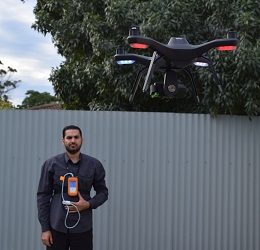We hear the words ‘pioneering’ and ‘innovation’ thrown around a lot in the drone industry. Often it’s an exaggeration. Rarely is it justified. Researchers at the University of South Australia appear to have made a discovery that could have genuinely transformative potential.
Their study has shown that drones can be used to detect human vital signs, with potential applications for the technology ranging from war zones and natural disasters to search and rescue missions.
Read more: Drones For Good: DJI and DroneSAR Deliver Search and Rescue App
Reading Vital Signs From Above
In case you didn’t quite catch that at the beginning: UniSA researchers have successfully trialled a system that uses unmanned aerial vehicles to measure heart and respiratory rates. While hovering a matter of metres away, these drones use remote-sensing imaging systems to detect changes in human skin tone and minute head movements in real time to read vital signs.
If perfected and put into practice, the technology could offer a low-cost, accurate and convenient way to monitor heart rates without physical restrictions.
The experimental results demonstrated that the proposed system with and without the magnification process achieves robust and accurate readings and have significant correlations compared to a standard pulse oximeter and Piezo respiratory belt. – Report: Remote monitoring of cardiorespiratory signals from a hovering unmanned aerial vehicle
Read more: Aerialtronics Announces PENSAR, Dual Spectrum Computer Vision Platform Integrating FLIR Boson
What Are The Applications of This Technology?
There are clearly plenty of possible applications for this technology. And when the software is combined with drones that potential increases. Researchers have already suggested that triaging disaster victims in earthquakes, detecting security and terrorism threats at airports, and remotely monitoring heart rates of premature babies in incubators could all be a possibility.

When testing the accuracy of the software, in both indoor and outdoor settings while within close range of the drones, the vital sign readings were as accurate as traditional contact methods, such as ECGs, pulse oximeters and respiratory belts.
“This is the first time that video from a hovering UAV has been used to measure cardiorespiratory signals,” said Professor Chahl, who led the team.
So far, testing has been carried out within three metres of humans. But researchers expect the drones to capture information at much greater distances once the technology perfected.
Researchers have suggested that a major application could be the detection of potential terrorists in public spaces. Because they are likely to have heightened heart rates, Professor Chahl sees a future involving these drones scanning crowds from high above.
“A person who is about to engage in violence will probably have anomalous behaviour and physiological signs. They might be highly agitated or unnaturally calm and in many cases they might be under the influence of drugs. There is a good chance that our system can detect these anomalies.”
“Obviously there are privacy and ethical issues around this technology that need to be resolved before it becomes common practice, but there is enormous potential to use machine vision systems to benefit society, particularly in the biomedical sphere.”
“I expect we will be using this software in everyday life in the next decade,” Professor Chahl says.
Malek Murison is a freelance writer and editor with a passion for tech trends and innovation. He handles product reviews, major releases and keeps an eye on the enthusiast market for DroneLife.
Email Malek
Twitter:@malekmurison
Subscribe to DroneLife here.







[…] Source […]